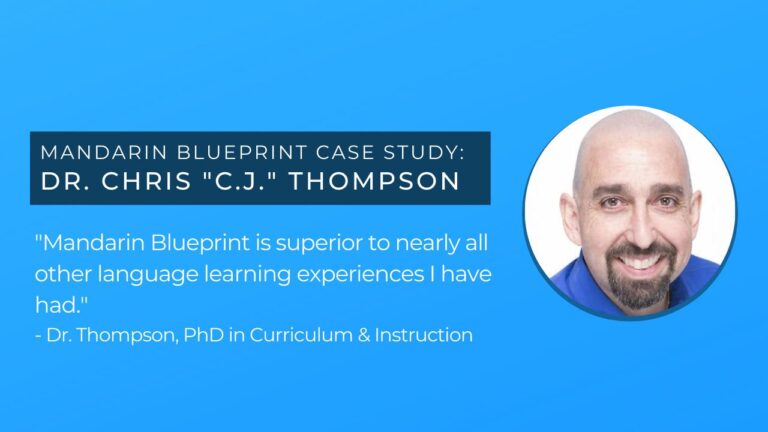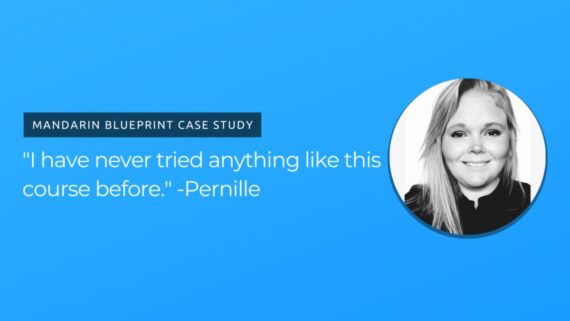Mandarin Blueprint Case Study – Chris “C. J.” Thompson

The following article is a Mandarin Blueprint Case Study. You can find more testimonials here.
Who Am I?
My name is Chris Thompson. I live in Houston, Texas in the United States. Currently, I work for a STEM curriculum development organization. Prior to that, I have had a variety of jobs in education. I began as a classroom teacher teaching mostly science, but some math. For more than a decade I taught science in ESL classrooms. This means I was working with students who were learning English. I have also worked at the district level and at the university. In addition, my bachelor’s degree, my master’s, and my doctorate are all in education. My main point is that I have had lots of experience in education, as well as study, training, and professional development.
My Language Journey
It’s probably worthwhile to give you my history with foreign language learning. I think this will provide context for everything else I talk about. Furthermore, I really had no serious exposure to a foreign language until high school. I took four years of Spanish in the late seventies and early eighties.
Not surprisingly, the instruction was pretty traditional but decent. After four years I had what you might call a solid foundation of Spanish learning, if not acquisition, a distinction Luke and Phil like to make clear. I was also hindered, no doubt, by my environment.
I was living in a small town in the midwest (Plymouth, MI) in a pre-internet era, so the chances for exposure to meaningful Spanish language interactions were almost nil. Even so, I did have enough of the basics. A few years later I moved to Houston for my first teaching position.
Pretty soon I was working in a classroom in which, for several hours each day, I was surrounded by Spanish speakers with little or no English. Also, I was dealing with parents who did not speak English and living in a place where Spanish was ubiquitous, on the radio, on television, and spoken in stores, restaurants, and other places of business. After a few years, I was pretty fluent. So Spanish was my one success story, although it took years of work.
Trying out various Resources before Mandarin Blueprint
Between graduating high school in 1981 and signing up for Mandarin Blueprint in 2020, however, I had a wide variety of language learning experiences. If you can name a language learning resource or method, I probably tried it. This includes physical resources such as textbooks and cassette tapes (yeah, I’m that old), source language materials (novels, magazines, and comic books in Spanish), as well as more modern technology.
I tried something called Transparent French in the nineties and have used several of the latest apps, including DuoLingo, and, more recently, some of the recommendations of Luke and Phil.
I have used native speakers as live resources, including language partners and penpals. Here in Houston, I took Hebrew classes at a local synagogue, introductory French at Alliance Française, and my daughter and I took a class at JASH (Japan America Society of Houston).
I’ve even taken a couple of college classes. I took advanced Spanish so I could add Spanish to my teaching certificate, and, in my freshman year of college, a year of Tagalog.
(This worked out since I ended up marrying a Filipina six years later). I’ve also made several attempts, none very serious, to learn a bit of Chinese, Korean, Vietnamese, Thai, Hindi, Russian, Latin, Arabic, Swedish, Norwegian, German, and Irish (Gaelic). Let’s be clear. I don’t speak any of those languages. I dabbled. Other than being able to recite a few words and phrases or sound out (poorly) words I don’t understand written in Katakana, Hebrew, or Cyrillic, I have little to show for my (admittedly meager) efforts.
What Makes Mandarin Blueprint Special
I spent the time on the introduction above to try to establish my bona fides when it comes to education in general and language learning in specific. In addition, I hope this provides context to what I have to say about Mandarin Blueprint (MB). I was asked to come up with three things I think make Mandarin Blueprint effective, but I struggled to get it down to four. Here they are.
The Foundation (Course Structure)
I can talk about components of the program I think are great, and I will do below, but I feel the need to start with what I think is the most important aspect of Mandarin Blueprint. The whole program, from the perspective of someone who knows education and language learning, is based on sound pedagogy and solid research in the topics of learning in general, language acquisition, memory, and motivation (a huge and often neglected part of learning).
For me, one of the clearest expressions of this is the overall structure of the course, what we call in curriculum development scope and sequence, what is taught, and in what order (Tschirner, 1996). This is the “blueprint” that gives the course its name.
This structure may seem unusual if you’ve taken traditional language courses. Your response may even be skeptical, as in, “This is not how languages are taught.” Some may even be frustrated if they begin with the pronunciation course (highly recommended!) and think, “I’ve been in the course for weeks now and I feel like I’m still just learning sounds!” while in a traditional course you might learn to say “Pleased to meet you,” or other “useful phrases” on Day 1. I was never skeptical or frustrated by the format. Hence, I saw clearly the genius of the system and its application to language research.
Learning Language Like a Native
I would challenge anyone who wonders about the course structure to ask yourself what is your end goal. If it is native fluency, then my response would be, if you want to speak like a native, you have to learn like a native. The root of the word native is the Latin natus meaning birth (like in nativity.)
You have to think of yourself as being newly born into Chinese. If you know anything about language acquisition theory you know that the first stage is babbling (Vihman, Ferguson, & Elbert, 1986).
Babies start out making random sounds. In fact, they make all the sounds of all the languages. (Good news, you made all the sounds of Mandarin when you were a baby)!
It could be a year before a baby starts to use words, and longer than that before they string them together in simple sentences. I have a three-year-old grandson and he has only recently started doing this. Meanwhile, you are exposed to written language and might know your alphabet before you start school.
Even so, reading is only really introduced in Kindergarten and taken seriously in first grade (at least in the U.S.). I never had a class called grammar until high school. Obviously, it won’t take several years to get to the grammar. My point is just that the order in which the course is set up makes perfect sense, from the standpoint of the research. The foundation of research, however, extends to individual components of the course, which is what I talk about below.
The Hanzi Movie Method of Mandarin Blueprint
It’s Based on Research
I’ll begin with the Hanzi Movie Method (HMM) because I have the most to say about it. To begin with, it is clearly based on solid research and the best current theories in memory. The connection and efficacy of visualization are documented in the literature in methods like the memory palace (McCabe, 2015), something that has made its way into pop-culture references like the television show Sherlock.
You can also find it in scholarly articles, in particular about language learning (Ostrikova, Zheltukhina, Zyubina, & Sidorova, 2018). I was familiar with the research when I tried to learn Chinese on my own and I, in fact, came up with my own, weak and ineffective method. It could not even be called a system. Anyone trying to learn Chinese characters probably has used something similar, trying to see objects (props) in the strokes and picturing some vivid scene that might be easily recalled. The problem with my amateurish method was that it was not systematic.
It’s systematic
Maybe I saw the same elements (props) in different characters and reused them, but even so, without a system, you have chaos, starting anew with each character. I had no system for which parts of my mental imagery coded for which parts of the word. The HMM, on the other hand, makes sure that every component of a scene (actor, set, props) carries information in an organized fashion about the word (initial, final, tone, how to write it).
Here’s the thing, though. Even if you or I had been brilliant enough to come up with a similar system, one that has all these components, we could not have developed the HMM on our own. It takes somebody who has the big picture. In other words, it takes somebody who already knows all the elements of pinyin and all the parts of the characters to make crucial decisions about how many actors are needed, and which kinds, how many sets, and where to draw the line between making a new prop, or combining old props.
The Hanzi Movie Method as memory hooks
So, the fact that the HMM has all the components to code for all the data you need to learn characters, I think there is another benefit to the method that makes it work so well. Every part of a movie is like a mental “handle” your brain can grab onto. (It reminds me of the old bop it! toy.) After two or three weeks of implementing the HMM, I can probably “get through” eight to twelve new characters per day. The truth is, though, that if I don’t see a new character for a few days, I struggle with it when next I see it.
However, because I can usually recognize one or more props when looking at a character, or visualize an actor or a set when I hear or see the pinyin, I can usually work my way to the missing parts. That’s what I mean by handles. Every part of the HMM is something you might remember, which can lead you to the other parts. The more handles, the more likely you are to retain the word. This concept of handles is part of memory theory and the term usually used is “hooks” (Nyikos, 1985), but I still prefer handle because it implies a sense of conscious control, of actively grabbing for a memory.
Even with all the benefits of the HMM, I will confess that I will often not recognize a new word if I don’t see it for a few days. I am at a total loss. I never worry, though, because I trust the Anki Decks to provide exactly the support I need.
The Anki Decks of Mandarin Blueprint
(Spaced Repetition Software)
Once Again, Based on Research
The HMM is a great way to create mnemonic devices that will allow you to remember new words, but it’s not the whole story. The scenes I create don’t stick with me in every detail from the moment I build them. This is where the Anki Decks come in. Like all the important components of Mandarin Blueprint, the Anki Decks are based on solid, established research. The Anki Decks are an example of Spaced-Repetition Software (SRS).
The basic idea is to present your brain with input frequently at first, and then less frequently as this input is fixed more firmly in your memory. You may be familiar with the basic idea of if you have ever taken a Pimsleur language course. Pimsleur came up with the idea of graduated-interval recall (Pimsleur, 1967) in the late ’60s and used it to design language instructions.
I once tried out a free introductory Arabic course from Pimsleur. To my mind, though, there were two real problems with the Pimsleur course. First, the graduated-interval recall method was being used to help you remember how to say things in Arabic, not how to speak Arabic.
Second, the course design was set, not responsive, like the SRS. The intervals for repetition may have been based on data about learners, but they were hard-wired into the course.
If you could recall something easily, too bad, you were going to see it frequently at first. If you were struggling to remember something, tough luck, it was going to start appearing less frequently and you, the learner, had no control. This is where SRS has the real advantage. You, the learner, have control over the interval so that you will see more frequently input you are having trouble with, and less frequently the stuff you already mastered.
“Trust the force”
The effectiveness of SRS is why I never worry about mastering new content. It works for all the elements (pronunciation, tone pairs, grammar, etc.), but here I’ll restrict myself to words/characters. As I said above, sometimes (often?) I will encounter a card in the Anki Deck with a character I can’t pronounce, even if I recognize the props, or I see the pinyin for a character I can’t remember how to write, even if I can recall the actor, or set, or both.
Without SRS I might be concerned that I had lost content and needed to drill myself on those specific words. That might have worked in the short term, but I would then have to remember to drill those words again at some later time. Keeping track of all that would be difficult.
With SRS I just hit the “Again” button if I can’t remember the word. I review the movie scene in my mind, maybe add special effects to make it more vivid and move on. Therefore, I know the word will reappear a couple of cards later and I will remember it. I can also be sure the card will show up again while it’s still fresh in my mind.
Other times I will not see a card for quite some time. When it reappears I might struggle to recall it, but I always do. At times like this I think to myself, “If that card had appeared a day or two later, I might not have remembered it.” I am confident that it showed up just in time to keep it in my memory. The algorithm is in the SRS work. I think of SRS like the force from Star Wars. I just relax and trust in it knowing I will be successful.
The Supplemental Videos of Mandarin Blueprint
The final component that I especially like about Mandarin Blueprint are the supplemental videos. By this, I mean the videos that don’t cover specific content but discuss larger ideas or themes. Sometimes these videos are just interesting or motivational.
I happen to like the videos about stroke order and grammar points, even if I don’t concern myself with mastering that content when I watch them. I appreciate the videos that recap progress. In education, we are told how important it is to let the learner know the expected outcomes and their progress towards the final goal.
Luke and Phil do a great job of that and I find it highly motivating. As I’ve pointed out above, the research behind Mandarin Blueprint is implicit in every component. However, I particularly like the videos that make explicit the research, in particular two diagrams.
Zone of Proximal Development
One of the diagrams used frequently shows concentric circles representing the ever-increasing mastery of Chinese as we progress through the course. This diagram always reminds me of Vygotsky’s Zone of Proximal Development (Chaiklin, 2003), a concept central to education theory.
Basically, the theory says what Luke and Phil repeat often, that effective learning occurs when the learner is presented with material that can be mostly understood but is slightly above their current level of mastery. This happens naturally when babies and children learn the language.
If parents only spoke to them in baby talk, they would not progress. If they provided nothing but college-level input, the children would not understand. The key is to find that sweet spot between content the learner has already mastered and content just above that level.
Flow
It’s important to note that this Zone of Proximal Development (ZoPD) is not the only key to learning, it is what motivates learners to keep working. In my current job, we talk a lot about gamification, the concept of turning learning activities into games.
Some people object, saying that that is just pandering to kids and that learning is a chore. Others argue that because many kids love games, in particular video games, we can leverage that to make learning fun and engaging.
I would argue not that video games can make learning fun, but that learning is what makes video games fun. I attended college in the early 80s at the height of the popularity of video arcades. My friends and I would often talk about what makes a video game addictive.
What is the format that makes you want to keep shoving quarters into the machine? Our conclusion was, basically the ZoPD, although we didn’t call it that. Level one of a game should be easy and intuitive. You should be able to master it quickly. New challenges should appear, though, to keep the game interesting, else you’d get bored and stop playing.
However, the game should not throw too much at you too quickly, otherwise, you’d get frustrated and walk away. That zone between a task so easy it’s boring, and one so difficult it causes frustration is not just the key to learning, it’s part of the theory of flow proposed by Mihaly Csikszentmihaly (1997).
In the zone
I read several of Csikszentmihaly’s books in the late 90s and early 2000s. I would recommend them. The theory summarizes that there is a condition or state of mind called “flow” achieved by successful athletes, artists, and others who have developed a skill set.
They achieve flow when they are engaged in an activity that is just challenging enough to be interesting, but also well within their ability. When they are in the state of flow they sometimes describe it as being “in the zone”. Time passes without them even noticing it.
They are almost in a trance but highly focused. This state of flow is what a gamer might experience when they are really “into” a favorite video game, or what a musician experiences when playing a piece of music.
It is what I experience when I am studying something at that perfect spot between mastery and challenge and this describes how I interact with Mandarin Blueprint. This is why, for me, studying every day is not a chore, but something I look forward to, and this is the direct result of the thoughtful design of the course.
Conclusion on Mandarin Blueprint
I could go on about why I think Mandarin Blueprint is superior to nearly all other language learning experiences I have had, but I want to get back to the course. So, I will leave you with something I recently composed, something of which I am extremely proud, a simple sentence in Chinese. 我很高兴认识你. (I am very happy to meet you.)
So, here I am, about six weeks into the course, and I have composed a sentence I might have learned on Day 1 of a traditional course. Why am I so pleased?
It’s because I constructed the sentence myself based on the language I had acquired through my study. This is not something I memorized. The difference is huge and it’s the reason I am confident that my success so far is meaningful and indicative of continued success in the future.
References
Chaiklin, S. (2003). The zone of proximal development in Vygotsky’s analysis of learning and instruction. Vygotsky’s educational theory in cultural context, 1(2), 39-64.
Csikszentmihalyi, M. (1997). Flow and education. NAMTA Journal, 22(2), 2-35.
McCabe, J. A. (2015). Location, location, location! Demonstrating the mnemonic benefit of the method of loci. Teaching of Psychology, 42(2), 169-173.
Nyikos, M. (1985). Memory Hooks and Other Mnemonic Devices: A Brief Overview for Language Teachers.
Ostrikova, G. N., Zheltukhina, M. R., Zyubina, I. A., & sidorova, I. G. (2018). Learning Via Visualization at the Present Stage of Teaching a Foreign Language. Astra Salvensis.
Pimsleur, P. (1967). A memory schedule. The Modern Language Journal, 51(2), 73-75.
Tschirner, E. (1996). Scope and sequence: Rethinking beginning foreign language instruction. The Modern Language Journal, 80(1), 1-14.
Vihman, M. M., Ferguson, C. A., & Elbert, M. (1986). Phonological development from babbling to speech: Common tendencies and individual differences. Applied Psycholinguistics, 7(1), 3-40.








